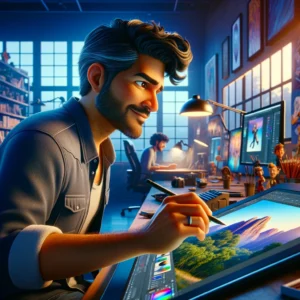The Rise of AI Art Generators
Unleashing Creativity with AI
The arrival of AI art generators like Midjourney and DALL-E has transformed the way we think about and produce graphic art. These tools enable the creation of visuals that were previously unimaginable, breaking down barriers for those with limited traditional design skills. My experience mirrors this trend, as I’ve moved from standard imagery to unique, captivating designs made possible by AI.
Midjourney: A New Frontier in Design
Midjourney’s introduction marked a pivotal moment in digital art, offering capabilities that drastically reduce the time and skill required to produce professional-grade visuals. This advancement signifies a leap towards more inclusive and diverse creative expressions within the industry.
DALL-E: Customizing Creativity
Similarly, DALL-E’s customizable features have allowed me to tailor AI art generators to specific needs. This personalization aspect is crucial for aligning with brand identities, such as BP Online Consulting and Management’s preference for Pixar-style art. The ability to train customized generators underscores the adaptability and potential of AI in graphic design.
Addressing the Challenges
Despite the progress, AI art generators face hurdles, particularly in rendering text within images. This issue highlights ongoing challenges but also the potential for significant advancements. Tools like Canva’s “Grab text” feature offer temporary solutions, indicating a pathway toward refining these technologies for better usability and output quality.
Transforming the Graphic Design Landscape
From Stock Images to Custom AI Creations
The shift from generic stock photos to AI-generated art marks a significant transformation in the graphic design industry. This change is not just about aesthetics; it’s about democratizing access to high-quality, personalized visuals. For small businesses and individuals, the affordability and accessibility of AI-generated art are game-changers, reducing reliance on expensive professional services.
The Cost-Effective Revolution
AI art generators represent a cost-effective solution for creating high-quality visuals. The ability to produce intricate designs in minutes, rather than hours or days, has opened up new possibilities for businesses and creatives alike. This efficiency can lead to significant savings and greater flexibility in content production, making professional-grade design more accessible to all.
Looking Ahead: The Future of AI in Graphic Design
The ongoing evolution of AI art generators promises even greater impacts on the graphic design industry. As these tools become more sophisticated, offering better control, customization, and realism, we can anticipate a future where the lines between AI-generated art and human-made creations become increasingly blurred.
Democratizing Art Creation
AI’s potential to democratize art creation is perhaps its most exciting aspect. By making it easier for people to produce compelling visuals, regardless of their technical skills or budget, AI is fostering a more inclusive and diverse creative landscape. This shift could lead to a richer, more vibrant array of digital content, reflecting a wider range of perspectives and experiences.
Conclusion
The integration of AI into graphic design is more than a technological trend; it’s a pivotal shift in how we create and appreciate art. As someone who has navigated this transition firsthand, I’ve seen the profound impact AI can have on creativity, efficiency, and accessibility. The future of graphic design, shaped by AI art generators, holds the promise of unlimited creative potential. For those interested in exploring this dynamic landscape, visiting the dedicated pages for BP Online Consulting and Management’s AI solutions can provide a starting point:
As the industry continues to evolve, the blend of human creativity with AI’s capabilities will undoubtedly unlock new horizons in graphic design, making it an exciting time to be a part of this transformative journey.

